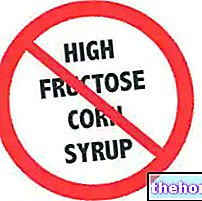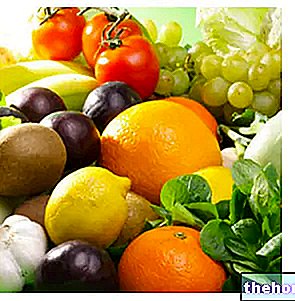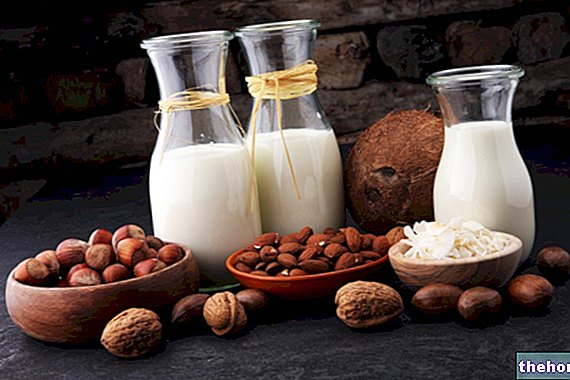Recent studies have shown that the best way to avoid obesity is to reduce total calories, regardless of the composition of the diet.
Additionally, sedentary and overweight people may become more resistant to the effects of insulin thus requiring more hormone to regulate blood glucose.
and oils, 2-3 servings a day of protein foods (milk, cheese, yogurt, meat, legumes, fish, nuts), 3-5 servings of fruit and vegetables, 6-11 servings of carbohydrates (bread, pasta, rice, etc. .). The message was therefore to minimize fat and consume plenty of carbohydrates, fruits and vegetables. At the time, the calorie consumption in the USA was: 45% carbohydrates, 40% fat, 15% protein. The guidelines of the American Hearth Association and other institutions recommended to consume at least 50% carbohydrates, 30% fat (today we are walking back).
In fact, no studies have shown long-term benefits attributable to a low-fat diet. The validity of these guidelines became even more questionable after the researchers showed that by increasing the ratio between total cholesterol (150-200 mg / dl in plasma from a healthy subject), and high-density (HDL) or good cholesterol, the risk of cardiovascular disease is raised, while a beneficial effect is obtained by reversing the relationship. Although limited, studies have unequivocally indicated the benefit of replacing saturated fats with polyunsaturated fats but not carbohydrates. Replacing fats with carbohydrates in fact involves a decrease in LDL and HDL and an increase in triglycerides (fats present in the blood in a physiological quantity of 72-170 mg / dl).
In truth, it was already known that some fats (unsaturated ones) are essential to the body and can reduce the risk of cardiovascular disease. In fact, dietary advice has always led to the replacement of saturated fats (dairy products and meats), which increase the cholesterol with the risk of heart attacks, with unsaturated oils (vegetable and fish oils) that lower cholesterol. In the USA the incidence of heart disease has halved and the consumption of polyunsaturated fats has doubled in the decade 1970-1980. This is confirmed by what happens in countries where oil is mainly used (in Crete it represents 40% of the caloric intake) or little use of fats (10% in Japan).
From 1992 onwards, further studies have gradually shown that this pyramid had many defects.
We now propose the most recent version of the food pyramid, proposed in 2016 by the International Foundation of Mediterranean Diet (Ifmed) during the first World Conference on the Mediterranean Diet held at Palazzo Lombardia, in Milan, which best reflects current knowledge on food.
they include bread, pasta, rice, cereals and starchy foods in general, potatoes, snacks and baked goods in general, snacks.
They are rich in carbohydrates and, if refined, or as they are normally consumed, do not bring beneficial substances contained in the germ and in the bran (vitamins, minerals, proteins, essential fatty acids and fibers) and are rapidly assimilated by the body. They therefore increase the level of glucose in the blood much more than wholemeal ones with a consequent insulin spike in the blood. The consequences are: increased sense of hunger (with a tendency to overweight and obesity) and vitamin depletion (especially B vitamins). high levels of glucose and insulin can have negative effects on the cardiovascular system by increasing triglycerides and blood pressure and decreasing HDL (the good cholesterol).
It should be noted that potatoes also carry this latter risk. In fact, a boiled potato increases blood sugars much more than a sugar cube, while providing the same calories. This happens because potatoes are essentially made up of starch which is absorbed quickly from our organism as glucose. Instead, common sugar, sucrose, is a disaccharide formed by a molecule of glucose and one of fructose; it is precisely the slow transformation of fructose into glucose that slows down the rise in blood sugar in the case of the sugar.
Epidemiological studies show that high intakes of refined flours and starches and potatoes are associated with a high risk of type 2 diabetes and cardiovascular disease and that this risk is higher in sedentary and less active people. Conversely, an increase in fiber consumption is associated with a lower risk of these diseases.
As for baked goods and snacks (snacks, chips, etc.), the risks mentioned above must be added to those, described in the following paragraph, due to the often present hydrogenated fats.
The healthy advantage of replacing refined cereals with whole grains is therefore evident even if, in this case, it will be advisable to opt for organic foods in order to avoid the risk of greater contamination by pesticides, more abundant, inevitably, in whole grains. (in the refining process, eliminating the surface layers of the grain also eliminates part of the contaminants).
. They consist of trans-unsaturated fatty acids (obtained by partial hydrogenation of vegetable oil making it solidify) and are present in margarines and in many baked goods and fried snacks: they raise LDL (bad cholesterol) and triglycerides.
Extensive epidemiological studies have not highlighted a particular role of fats in colon and breast cancers. Other studies have associated prostate cancer with the consumption of animal fats (rich in saturated fatty acids) but have not shown any role for vegetable oils, which on the contrary can slightly reduce the risk. Finally, regarding cardiovascular problems, studies have unequivocally indicated the advantage of replacing saturated fats (animal fats) with polyunsaturated fats (vegetable and fish oils).
and potassium). Folic acid (present in green leafy vegetables) can also reduce the risk of colon cancer and its inadequate intake is responsible for birth defects. Lycopene (contained in tomatoes) reduces the risk of prostate cancer. consumption of lutein (pigment present in green leaves) increases the risk of cataracts and retinal degeneration.
We know that we get the maximum benefit from fruits and vegetables if we consume them fresh and raw, because they allow the maximum use of their vitamins and minerals, but also if they have been harvested ripe. Unfortunately, these precious foods are often harvested at "harvest maturity" or, for speculative reasons, as soon as possible, thus becoming food of little value.
, peanuts, etc., contain a lot of fat but mostly polyunsaturated (especially walnuts are a good source of omega-3s). Studies show that they reduce triglycerides., Decrease the risk of heart disease. In addition, those who eat dried fruit tend less towards obesity due to the satisfaction of the resulting appetite. , peas, chickpeas, lentils, broad beans, soybeans, peanuts are an "important source of energy and protein. Dried legumes contain a percentage of protein equal to that of meat (20%) but of lesser biological value; they contain a lot of amino acid lysine but few sulfur amino acids (methionion and especially cysteine which are instead abundant in cereals). The exception is soy which has a protein content of 38% without limiting amino acids. However, combining them with foods rich in sulfur amino acids, such as cereals, you get an excellent meal with a cost 6-7 times lower than the equivalent with meat (eg 50g of legumes and 200g of cereals + vegetables + condiments = 1000 kcal and covers 2/3 of the daily protein requirement).
Before cooking, it is advisable to soak for 12-24 h (the water must be changed 2-3 times) as it decreases the quantity of indigestible substances (saponins), chelators (phytic acid which binds iron Fe) and antivitamins.
It should also be added that leguminous plants are "improving" plants due to the presence, in the roots, of bacteria that fix atmospheric nitrogen (all the other plants instead absorb it from the soil). Since not all nitrogen is used by leguminous plants, the subsequent crop benefits from this "donation". This cultivation technique ensures that the soil is not impoverished. Today, the introduction of chemical fertilizers has made the rotation disappear to give way to monoculture, called "robbery" agriculture, which is more profitable (consequently the development of agricultural machinery has mostly concerned corn and wheat).
it is associated with the risk of cardiovascular diseases, due to the high content of saturated fats and cholesterol, diabetes 2 and colon cancer; the latter probably due to the carcinogenic substances formed during cooking or due to preservatives.With regard to sausages, it must unfortunately be added that they are products through which the industry too often sells raw materials of very poor quality at a high price and over which no form of control by the consumer is possible. Undoubtedly the exceptions are raw ham and bresaola whose production system does not allow for sophistication (see: nitrites nitrates).
Poultry (white meats) and fish contain less saturated fat and more unsaturated fat. Fish is also a rich source of omega-3 fatty acids.Substituting poultry and fish for red meat reduces the risk of cardiovascular disease and colon cancer.
Regarding white meat, however, the risk that they contain estrogen (used to increase the weight of young animals) capable of causing hormonal imbalances in children should also be mentioned. The control of the origin of the food is therefore always important.
they contain a lot of cholesterol but don't seem to cause any problems. The maximum recommended consumption is 1 per day (except for diabetics).
Freshness test: test of "floating" in a basin with water, the fresh egg settles on the bottom in a horizontal position and then, over time, it becomes vertical, if it is old it floats.
The digestibility of eggs varies according to the way they are cooked: the best way is soft-boiled, poached or poached egg (i.e. with low cooking time).
(Ca). In fact, high fracture rates have been found in countries with the highest consumption of dairy products. In Italy, in the 1960s, calcium intake was ½ compared to that of northern Europe and there was less osteoporosis than in those countries. There are no studies that show that their consumption reduces osteoporosis. Instead, it is the excess of animal proteins and the salt contained in the cheese that favor the excretion of calcium. Furthermore, studies seem to correlate dairy products with the risk of cancer. prostate and ovarian. So to fight osteoporosis it is better to take more proteins of vegetable origin and to exercise. See also: diet and osteoporosisVery aged cheeses can be harmful for those who use antidepressants as the latter block the degradation of tyramine (a powerful vasoconstrictor present in highly fermented cheeses).
Processed cheeses are normally made from spoiled cheeses and returns. They are not recommended due to the presence of polyphosphates (melting salts), especially for children, as they unbalance the calcium / phosphorus ratio (Ca / P). Furthermore they are made up of 50-60% in water.
Milk: mother's milk is the only food capable of allowing the baby to grow. Drinking milk is cow's milk which has more vitamins thiamine and B12 than the mother's milk, more than triple the protein and less lactose. In this regard, it should be emphasized that: the vitamins and lipids of breast milk depend on the mother's diet and that 1/3 of breastfed with colic improves if mothers stop drinking milk. Furthermore, the production of the lactase enzyme, essential for the digestion of milk by the intestine, is reduced and ceases in 30% of people after weaning. Milk intolerance, after weaning, is therefore to be considered physiological.
together with fruit and vegetables it is associated with lower mortality from heart disease and stroke, thanks to the contribution of antioxidants (carotenoids, tocopherols, ascorbic acid, flavonoids) which act synergistically. Moderate quantities of red wine determine greater stability of the plasma and of LDL against oxidation and increases the presence of HDL. Alcohol decreases platelet aggregation in the blood by limiting the formation of clots and thrombi. 40g of alcohol / day (300ml of wine) for men and 20g for women decrease the risk of coronary heart disease by 30%. If drunk in excess it can cause serious damage to the liver, where it has the greatest effects ( steatosis, hepatitis and cirrhosis), stomach (gastritis due to excess production of hydrochloric acid), has a depressing effect on the central snow system with attenuation of inhibitory brakes and clouding of reflexes (50% of homicides and 25% of suicides are performed under the effect of alcohol), creates peripheral vasodilation (it draws blood from the heart and muscles, causing fatigue and cooling). Finally, wine is the food product that undergoes the greatest sophistication.
Beer is one of the least adulterated beverages.
Alcoholic aperitifs, in most cases, derive from industrial alcohol rectified by adding additives.
(bread, pasta, rice, etc.). At almost all meals, vegetable oils (if fats and carbohydrates are healthy, you probably don't need to worry too much about their caloric%). Plenty of vegetables and fruit. Moderate quantities (1-3 servings / day) of healthy protein sources (nuts, legumes, fish, lean meat, eggs) and alcohol (unless contraindications such as: pregnant women, liver disorders, pancreatic, congestive heart failure, idiopathic myocardiopathy, degenerative neurological diseases). The consumption of dairy products is even lower (2-3 servings per day). Minimum consumption of: refined cereals (including sugar and potatoes), butter, red (fatty) meat. No hydrogenated fats (margarines).









.jpg)


















